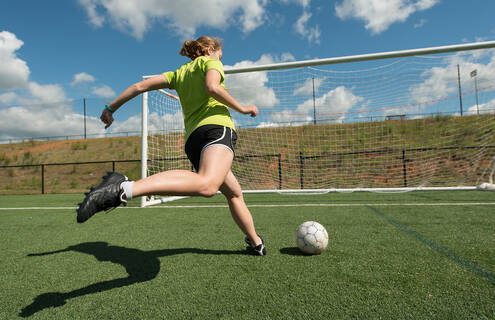
This article is written by Cheshire Medical Center Registered Dietitian Amy Ansaldo, RD, LD, and Chair of Sports Medicine Neal Goldenberg, MD.
Most of us know the benefits of regular physical activity: improved heart health, decreased risk of diabetes, improved self-esteem — the list goes on and on.
Playing sports and getting plenty of physical activity is also associated with bone health.
However, a medical condition called the “female athlete triad” can negatively affect physically active females. The American College of Sports Medicine first identified the concept in 1992 after a pattern was recognized among young adult female athlete patients. The three components of the female athlete triad include:
- Low energy availability is an imbalance of energy intake versus expenditure. It happens when you burn more calories than you take in. This may be unintentional and can occur in male and female athletes who do not have adequate fuel to support energy demands and have low energy availability. The term relative energy deficiency in sport (RED-S) refers to this constellation of symptoms of poor health and declining athletic performance.
- Menstrual dysfunction — the most known example of endocrine dysfunction — is “a lack of regular menstrual periods occurring every 21 to 45 days beginning 1 to 2 years after the first menstrual period starts.” A loss of a normal period can cause changes in normal hormone levels, possibly causing lasting effects.
- Low bone mineral density is a condition that causes bone mineral density (minerals like calcium) to decrease, increasing your risk of osteoporosis, bone stress injuries and even fractures.
Signs and symptoms
Here are some signs that may indicate a female athlete is overtraining, feeling increased stress, actively dieting, or losing weight:
- Poor performance: They may complain of feeling like they are “hitting a wall” no matter how hard they train.
- Stress fractures or overuse injuries: Pain that does not resolve with rest days should checked out by your doctor.
- Anxiety around food, weight loss, low self-esteem, or poor body image: Your athlete should eat throughout the day and listen to their body for hunger cues. If they are suddenly not hungry at the times they used to be, ask questions and find out what they are eating when not at home. Worrying about their weight, negative self-talk, or comparing themselves to others more noticeably could be signs of low self-esteem or poor body image. If your athlete is exhibiting signs of disordered eating, reach out to their primary care provider or a registered dietitian.
Many reasons exist to address and treat this condition due to its impact on long-term health outcomes.
How does this happen?
Low energy availability can result from overtraining, inadequate intake of healthy calories, or both. This can lead to changes in our endocrine system, affecting estrogen (in females) and testosterone levels (in males), menstrual irregularity (including amenorrhea—when one stops having a period), and decreased bone mineral density.
Our body's bone mineral density increases until age 25 to 30, then, gradual bone loss begins. It’s important for people under 25 to achieve appropriate bone growth and bone strength since there are lifelong implications for one's overall bone health.
Steps and solutions
There are some steps you can take in the right direction. They include:
- Recognizing the signs of the female athlete triad and speaking to your support system (coaches, athletic trainers, dietician, and your doctor).
- Increasing nutrition intake throughout the day; all the food groups are needed.
- Start taking a daily multivitamin (even a gummy vitamin) to meet micronutrient needs. (Find out if vitamin D and calcium are recommended by your primary care provider.)
- Decrease the training load and add more rest days to their schedule. Or, try a different activity, cross-training, or lower-impact movement, such as yoga.
- Check in every month to ensure menstruation has returned and is maintained.
The signs of the female athlete triad can range from subtle to more severe.
If you suspect your athlete may be experiencing low energy availability, a sports medicine physician can help. Contact your primary care provider or one of the Sports Medicine specialists in our Orthopaedics department.
Together, we can help improve the health of our athletes and our community.